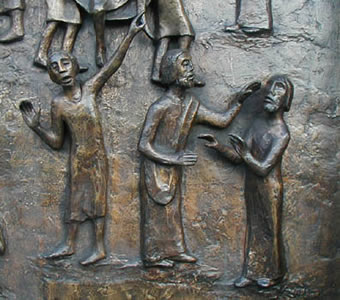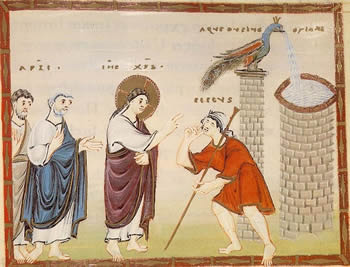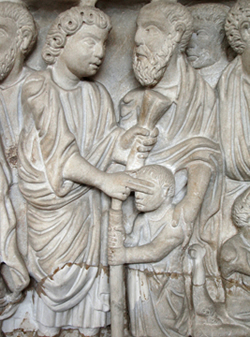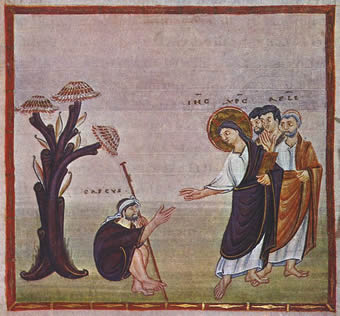From Our Archives
For other essays on this week's texts, see Sr. Nancy Usselmann, FSP, The Light of Grace (2017); and Debie Thomas, Now I See (2020).
For Sunday March 19, 2023
The Fourth Sunday in Lent
Lectionary Readings (Revised Common Lectionary, Year A)
1 Samuel 16 :1–13
Psalm 23
Ephesians 5:8–14
John 9:1–41
This Week's Essay
What do you see — one vase or two faces? That's the optical illusion made famous by the Danish psychologist Edgar Rubin (1886–1951), who specialized in "figure-ground perception." When shown a simple picture of his Rubin Vase, some people see a white vase on a black background. Other people see two black faces on a white background.
What you see doesn't depend on the image. You can choose to see the "other" image by reversing the object in the foreground and its background. How the brain processes vision is dynamic and malleable. The Rubin Vase is interesting because it demonstrates how different people looking at the same object can see different things.
In the readings from 1 Samuel 16 and John 9 this week, people look at the same thing but they see it very differently. The lectionary challenges us to see the world like God does, rather than from a normal human perspective. To see things like God does is an essential part of being God's people in the world. You might say that we want to be careful not to confuse the vase and the face.
 |
|
Detail of ceremonial bronze door, St. James Cathedral, Seattle, by Ulrich Henn.
|
The street lawyer William Stringfellow once said that he wanted to see America biblically, rather than to read the Bible Americanly. Similarly, we want to see the world from God's perspective, rather than to view God from the world's perspective.
This sounds well and good, but to see like God does encounters the two dangers of audacity and futility. Who in their right mind would be so rash as to claim to share God's perspective? And conversely, who isn't aware of how many ways our perspectives are shaped, limited, and compromised? "I see in a glass only darkly," said Paul.
In fact, the gospel for this week suggests a counter-intuitive way beyond these obstacles. To see like God does requires radical vision correction, for God doesn't look at the world like we do.
In 1 Samuel 16, Samuel anointed David as Israel's new king only after looking at his seven brawny brothers and hearing God dismiss every one of them: "This is not the one." That's because "the Lord does not look at the things that man looks at. Man looks at the outward appearance, but the Lord looks at the heart." David was the youngest and most unlikely political prospect, but God chose him as the new king of Israel, and so "from that day on the Spirit of the Lord came upon David in power."
 |
|
Healing of the man born blind, Germany, c. 980-993.
|
John 9:1–41 recounts the healing of a beggar who was born blind. But the details of the miracle itself comprise only about one third of the narrative. Most of the story revolves around the disputes that the miracle provoked, and how different people drew different conclusions even though they all saw the same thing.
There are so many fascinating details in this story that merit attention: precise descriptions about spit, mud, and the interrogation of parents that characterize an eyewitness account; the disinterest about Jesus on the part of the blind man who received the miracle; the inexcusably cruel insinuation by the disciples that the beggar's blindness was an act of divine punishment; the inherent scepticism and suspicion surrounding the plausibility of a genuine miracle (so much for the gullibility of ancient people about miracles!); the complex factors that can prevent a true miracle from eliciting genuine faith; and the interactions among the characters in the larger drama — Jesus, his disciples, the blind beggar, his parents, the religious elite, and even the larger community.
 |
|
Healing of the man born blind, detail of 4th century sarcophagus.
|
The professional clergy made all the wrong moves in this story. They refused to believe eye-witness accounts of the miracle. They were more concerned to maintain ritual righteousness about Sabbath-keeping than to love another human being and rejoice in his wholeness. They blabbered pious cliches. They scapegoated the victim and "hurled insults" at him. They condescendingly claimed a spiritual elitism that intentionally humiliated the beggar. They demonized him as a "sinner." As they threw him out of the synagogue, their rage exploded, "How dare you lecture us!" With that, their own tragic blindness was confirmed, and we learn that it was their spiritual blindness, and not the physical blindness of the beggar, that forms the central plot of the story.
The story concludes with a punch line that is enigmatic and disturbing: "For judgment I have come into this world, so that the blind will see and those who see will become blind." When some Pharisees asked if they were blind, Jesus responded, "If you were blind, you would not be guilty of sin; but now that you claim you can see, your guilt remains."
Physical blindness is bad enough. But Jesus flips the script and moves from the literal to the spiritual — the claim to see is far more tragic, for it masks a blindness to our need for corrective vision.
One of the most dangerous spiritual places that we can live is in the deluded notion that we are fully-sighted, spiritually-speaking. Conversely, the healthiest place to live is not only to acknowledge our spiritual blindness, but also to embrace that as an acceptable place to live.
The Israeli poet Yehuda Amichai (1924–2000) captures this paradox in his poem:
From the place where we are right
Flowers will never grow
In the spring.The place where we are right
Is hard and trampled
Like a yard.But doubts and loves
Dig up the world
Like a mole, a plow.
And a whisper will be heard in the place
Where the ruined
House once stood.
In acknowledging our blindness, Jesus says that we live in the light; by believing that we see fully and rightly, as the Pharisees claimed, we stumble in the darkness.
Acknowledging our spiritual blindness can be embarrassing and threatening. After all, people want clear and concise answers. We know from experience, and from the disciples and the clerics in John 9, how cruel and condescending, how derogatory and dismissive, people can be towards the blind. Many people said that the man's blindness was God's punishment, but Jesus repudiated that cruel conclusion (just like he did in Luke 13 in response to another human tragedy).
Healthy people befriend their blindness and make their peace with it. Spiritually-sighted people recognize that acknowledging their blindness is an act of liberation not a confession of bondage. The journey toward the light begins when we acknowledge our darkness. And that's partly what we do at Lent, we make peace with our imperfections.
In her essay on the transfiguration of Jesus, Amy Frykholm considers our own transfiguration. She observes how difficult it is to see the world and ourselves like God does. Old habits die hard. Our field of vision is distorted by past choices.
 |
|
Healing the blind man of Jericho, Germany, c. 980-993
. |
Frykholm draws on Annie Dillard’s essay Seeing, in which Dillard describes a person born blind whose sight was restored through surgery — a healing similar to this week's gospel. But seeing the world with new vision was much harder than you might think.
Frykholm writes: "The person had to reconcile preconceived notions of the world with objects, colors and distances. Much of what she saw simply felt wrong. A newly sighted person can easily get the meanings wrong, even though she has a radical new gift. This suggests a spiritual kind of sight as well as a physical — that a person having received a radical new gift might struggle to understand precisely how to use it."
Jesus calls himself "the light of the world" (John 9:5). In his prologue John uses this image of light seven times. In the epistle for this week, Paul urges the Ephesians to "live in the light" and repudiate the "deeds of darkness." It's a powerful metaphor.
Jesus enlightens our darkness. He heals our blindness. But in doing so he is also the Great Divider: "For judgment I have come into this world, so that the blind will see and those who see will become blind. If you were blind, you would not be guilty of sin; but now that you claim you can see, your guilt remains."
NOTE: See Amy Frykholm's guest essay.
Weekly Prayer
John Milton (1608–1674)
Sonnet 19 When I Consider How My Light Is Spent
NOTE: John Milton began to lose his sight in his forties, and in this poem he struggles with his blindness and its implications for his vocation, when his life was barely half over.
When I consider how my light is spent,
Ere half my days in this dark world and wide,
And that one talent which is death to hide
Lodged with me useless, though my soul more bent
To serve therewith my Maker, and present
My true account, lest He returning chide;
"Doth God exact day-labor, light denied?"
I fondly ask. But Patience, to prevent
That murmur, soon replies, "God doth not need
Either man's work or His own gifts. Who best
Bear His mild yoke, they serve Him best. His state
Is kingly: thousands at His bidding speed,
And post o'er land and ocean without rest;
They also serve who only stand and wait."
Dan Clendenin: dan@journeywithjesus.net
Image credits: (1) St. James Cathedral, Seattle, USA; (2) Wikimedia.org; (3) cleansingfiredor.com; and (4) Wikimedia.org.





